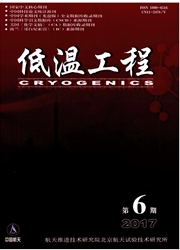

 中文摘要:
中文摘要:
针对詹姆斯·韦伯太空望远镜的中红外仪冷却系统中J-T节流循环的热力学计算分析结果表明,适当地降低末级预冷温度、提高压比和提高末级间壁式换热器效率是J-T节流循环制冷性能提升的关键。考虑该复合型低温制冷机的整机效率,结合当前脉管制冷机和驱动J-T节流循环的线性压缩机的性能水平,探讨了预冷温度和J-T节流循环压力的优化方法。计算结果表明优化后的预冷温度和J-T节流循环压力使复合型低温制冷机的性能高于原预冷温度和J-T节流循环压力下性能的计算值,实际具体的脉管制冷机和J-T节流循环压缩机性能是实现准确优化的必要条件。
 英文摘要:
英文摘要:
A hybrid cryocooler consisting of a three-stage pulse tube cryocooler and a J-T cryocooler was employed as the MIRI cryogenic system in the James Webb Space Telescope. Based on the J-T loop of the hybrid cryocooler,the thermodynamic calculation results show that the appropriate lower precooling temperature,higher pressure ratio and higher recuperator effectiveness are the keys to improve the performance of the J-T loop. Taking the overall efficiency of the hybrid cryocooler into account,the optimization of precooling temperatures and pressures of the J-T loop is discussed referring to the current level of the performance both of the pulse tube cryocoolers and the linear compressors of the J-T loops. The optimized precooling temperature and pressures can make the the performance of the hybrid cryocooer better than that calculated from the origin parameters. The actual performance of the pulse tube cryocooler and the J-T compressor is a requirement for accurate optimization.
 同期刊论文项目
同期刊论文项目
 同项目期刊论文
同项目期刊论文
 期刊信息
期刊信息
